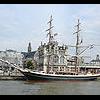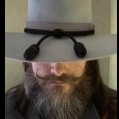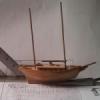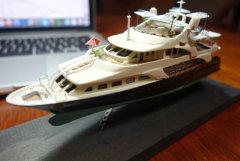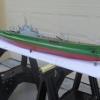-
Posts
461 -
Joined
-
Last visited
Reputation Activity
-
 Chasseur reacted to Piet in Top sail schooner by Piet - FINISHED - 1:2000 - BOTTLE - shipyard diorama
Chasseur reacted to Piet in Top sail schooner by Piet - FINISHED - 1:2000 - BOTTLE - shipyard diorama
Hello everyone and best wishes. Thank you Mark, Igor, Carl, Julie Mo and Patrick for your very kind words and of course a heartfelt thanks to all who clicked the like button.
This will most likely be the last post of my effort to make a micro mini diorama. It's not a Dutch shipyard as Amateur Jan would have liked but I opted for something we could expect somewhere in New England.
Is it perfect? No, not by a long shot but the main thing is that I learned a lot and had a lot of fun doing it. There is still that Dutch jacht or fishing boat in a lamp awaiting to do - - - - someday.
Thank you all for visiting and your helpful hints and encouragement along the way. My next "little" project will be started in the kit building section but I'll also continue with my VOC ship Surabaya. Gwen would like to see it finished so I can start with her father's ship, the Musi.
Here are a few pics I picked out for you to look at.
Here I have numbered the various details to annotate what they are. #1 is the 35 foot supply sloop. #2 is the wooden dock the sloop is tied to. #3 are two of the ship's frames. #4 are two of the canted frames. #5 are stacks f hull planks. $6 is a stack of deck planks. #7 is a 95 foot schooner on the ways in the early stage of being build. #8 are logs. #9 is the steam power shed to run the saw with its smokestack. #10 is the sawmill. #11 is a stack of freshly cut planks. #12 is the machine shop. #13 topsail schooner in the stocks close to being launched. She has most of the standing rigging installed. #14 is the 15 foot ship's boat moored to a pole on shore.
As a reminder, the sails on the supply sloop is from VERY thin cloth packing material of a package with sail cloth Igor uses for his bottle ships he send me. Thanks again Igor, much appreciated and as you see even the packing cloth came to good use. Te actual sail cloth will be used for the future build for my planned boat in a lamp, see my signature.
]
Here I did a "Patrick" by putting the diorama on the palm of my hand. This shows how small it actually is. The width of my palm is 50 mm and the diameter of the diorama is 35 mm.
Cheers,
-
 Chasseur reacted to Omega1234 in Majellan by Omega1234 - FINISHED - 1/200 - Luxury 37 m Motor Yacht - Miniature
Chasseur reacted to Omega1234 in Majellan by Omega1234 - FINISHED - 1/200 - Luxury 37 m Motor Yacht - Miniature
Thanks David
Ahhh! Fishing! What a coincidence that you've mentioned 'fishing' because I have actually toyed with the idea of leaving a couple of fishing rods casually placed in the ship's tender. However, at this scale, they'd be so tiny that they'd be hard to see.
Still, who knows. I may yet give them a go. No harm in trying, I guess.
Have a great week.
Cheers
Patrick
-
 Chasseur got a reaction from Elijah in Syren by JesseLee - FINISHED - Model Shipways - scale: 1:64
Chasseur got a reaction from Elijah in Syren by JesseLee - FINISHED - Model Shipways - scale: 1:64
Good to see you in the man cave hobbying. Looking good my friend!
Jeff
-
 Chasseur got a reaction from mtaylor in Syren by JesseLee - FINISHED - Model Shipways - scale: 1:64
Chasseur got a reaction from mtaylor in Syren by JesseLee - FINISHED - Model Shipways - scale: 1:64
Good to see you in the man cave hobbying. Looking good my friend!
Jeff
-
 Chasseur got a reaction from JesseLee in Syren by JesseLee - FINISHED - Model Shipways - scale: 1:64
Chasseur got a reaction from JesseLee in Syren by JesseLee - FINISHED - Model Shipways - scale: 1:64
Good to see you in the man cave hobbying. Looking good my friend!
Jeff
-
 Chasseur reacted to Canute in Syren by JesseLee - FINISHED - Model Shipways - scale: 1:64
Chasseur reacted to Canute in Syren by JesseLee - FINISHED - Model Shipways - scale: 1:64
Nice work lowering the carronades, Jesse.
-
 Chasseur got a reaction from cog in Syren by JesseLee - FINISHED - Model Shipways - scale: 1:64
Chasseur got a reaction from cog in Syren by JesseLee - FINISHED - Model Shipways - scale: 1:64
Good to see you in the man cave hobbying. Looking good my friend!
Jeff
-
 Chasseur got a reaction from mtaylor in Great Republic 1853 by rwiederrich - FINISHED - four masted extreme clipper
Chasseur got a reaction from mtaylor in Great Republic 1853 by rwiederrich - FINISHED - four masted extreme clipper
I like the effect the dull coat had on the black paint. It's given a subtle looking weathering effect!
Looking good Rob*
-
 Chasseur got a reaction from Canute in Syren by JesseLee - FINISHED - Model Shipways - scale: 1:64
Chasseur got a reaction from Canute in Syren by JesseLee - FINISHED - Model Shipways - scale: 1:64
Good to see you in the man cave hobbying. Looking good my friend!
Jeff
-
 Chasseur reacted to Mike Dowling in Airbrush
Chasseur reacted to Mike Dowling in Airbrush
OK, OK I give in !! Thanks Robin for your suggestion. I found on today with a decent discount so it is on it's way to me. Watch this space !!
-
 Chasseur got a reaction from Omega1234 in Great Republic 1853 by rwiederrich - FINISHED - four masted extreme clipper
Chasseur got a reaction from Omega1234 in Great Republic 1853 by rwiederrich - FINISHED - four masted extreme clipper
I like the effect the dull coat had on the black paint. It's given a subtle looking weathering effect!
Looking good Rob*
-
 Chasseur reacted to dgbot in Airbrush
Chasseur reacted to dgbot in Airbrush
Mike, many years ago I started out with a Paasche H. It is a single action airbrush for a good price. After a bit of practice I used it for all of my painting. Simple and basic and still considered a workhorse. I bought a Badger 360 which I had to relearn many things. But it was worth it. Kurt is correct in saying acrylics are the way to go. I attended many club meetings hwere he gave talks on airbrushing and to me is still to go to man. Once you get used to an airbrush you will not look back. And remember practice,practice,practice and keep it clean.
David B
-
 Chasseur got a reaction from WackoWolf in Airbrush
Chasseur got a reaction from WackoWolf in Airbrush
Hi Mike,
Years ago I picked up a Paasche double action brush and compressor for around 100 CAD. I did a lot of research before I bought it. Over the years the brush has been flawless. Here are my experiences:
Pressure and pattern is crucial.
The right paint and thinner consistency is crucial.
Never mix paints with other brands of thinners.
Acrylics are a bit tricky and you must use the same brand of thinner no exceptions!
Some guys swear you can thin acrylics with windex window cleaner and a touch of dish soap. I tried the aforementioned and I am not thoroughly convinced.
Some guys say you need a water separator and pressure regulator however I have never had an issue using my brush straight out of the box. The only caveat I'll add here is if you live close to the coast and relative humidity is high then get a separator if you see water vapour flying out of the tip. Remember H2O is considered a solvent and will thin paint so using water based paints is not an issue without a water separator.
I find the right size of tip/nozzle combination is the key to success for what you are trying to paint. I can get away with not using a regulator here as matching the tip and cup restricts flow and what is going on at the tip is where the rubber meets the road. The tatto guys are big on pressure regulation as they don't want inks to wash out but on model ships IMHO spray pattern and control is all that is required and... if you purchase a double acting brush you will achieve the aforementioned without the cost of an additional regulator.
Practice, Practice, Practice some more.
Learning how your brush operates is key and like everyone has said keeping it clean and free of dried paint is not an option.
When it comes to paint do not cheap out here. Buy the best paint you can afford that is designed for use in a brush. I personally prefer Testors Model Master Paints whether acrylics or enamels. What ever you do always wear at the minimum an N-95 respirator for acrylics and an Organic Vapor Cartridge type of half mask respirator when spraying enamels. If you do enamels be cognizant they stink the man cave up and the rest of your house for that matter. If you want to use enamels you'll need either a spray booth with filters or do it outside on a warm sunny day in the shade preferably with little to no wind.
One final note.... Preparation is 9/10ths of the job. Using the right shade of primer to match your base coat is key. Grey primer is good for lighter Colors where as red oxide is good for the darker Colors. Using medium to fine sand paper between coats will really enhance your finish. If you want an outstanding paint job Google the plastic car modellers sites on the Web. These guys go all out and are painting like automotive technicians do. Remember if it's a ship model the weathering is what will make your model stand out from the rest. Please don't over do the aforementioned and weather appropriately.
The more you paint with an airbrush the better you'll get. Practice and experience does make the difference here. Hope this helps ... Jeff
-
 Chasseur got a reaction from IgorSky in Preussen by Chasseur - BOTTLE - barque
Chasseur got a reaction from IgorSky in Preussen by Chasseur - BOTTLE - barque
Rob, Patrick, and Carl
Thanks for the encouragement greatly appreciated. Thanks for the likes :-)
You guys are the best ... Jeff
-
 Chasseur got a reaction from mtaylor in Preussen by Chasseur - BOTTLE - barque
Chasseur got a reaction from mtaylor in Preussen by Chasseur - BOTTLE - barque
Rob, Patrick, and Carl
Thanks for the encouragement greatly appreciated. Thanks for the likes :-)
You guys are the best ... Jeff
-
 Chasseur got a reaction from Piet in Preussen by Chasseur - BOTTLE - barque
Chasseur got a reaction from Piet in Preussen by Chasseur - BOTTLE - barque
Life has a way of getting in between work and hobbies. The last year and most of this year to date has been trying for our family as we watched my Father in Law go from an old folk’s home to a cane, to a walker, to a nursing home and wheel chair. He has been diagnosed with Parkinson's and is basically bed ridden.
The aforementioned has been a huge stressor on all of us… especially my wife. BTW the Mother in Law has Alzheimer's disease. A man can count his blessings each day as he wakes and enjoys life with good health. Zero work has been done with regard to the Preussen as we have had to deal with hospitals, doctors, nurses, healthcare workers et al.
Between works, writing an article for Lone Warrior and working with my son on his 1973 Chevy SS Nova I do manage to get some hobby done here and there. I thought I would share this tool below I built for making ratlines.
Inspiration for this tool came from The Bottle Shipwright 1989 No. 1 Vol. 7, Page 12 ... Journal of the Ships in Bottles Association of America (SIBAA). Author: Hans de Haan Holland.
This tool was made to complete HMS Lady Prevost and USS Ariel (1:300 scale.) models for the L.W. article. I plan to eventually use the tool for making the ratlines for the Preussen as well and will use Ralph Preston's technique of installation with a minor tweak of my own to eliminate 150 strings coming out of the hull and bottle neck ... Story line in the future.
As with every tool I make the unwritten rule is the materials have to be had from within the man cave. I quickly hunted down some brass square tubing, a spring, screws etc. to fabricate this tool. Parameters were... it had to be adjustable for different mast heights, differing scales of model ships, and it had to fit into my fly tying vice for easy work access.
As with any soldering the trick with small parts is holding them down while you tin and solder the joints. My butane mini torch and pencil tip soldering iron came in handy while my adjustable second hand held everything square to the earth.
I chose a small spring to maintain spacing and tension to keep the lines taunt. This picture below shows my first feeble attempt while trying to glue things on a flat surface. If you look closely you can see that the glue gets bunged up and things got stuck to the first balsa wood jig I made which a nightmare was trying to remove the ratlines once completed.
Above: Note the miniature Deadeyes made from paper to scale. Technique here is print them side by side, cut out and fold, then glue to thread.
Next pictures show the new tool I fabricated and the steps to completion and paint.
Above: You can see how the spring holds adequate tension and spacing and the bottom part is made to depict breadth and spacing of lines. I can even tweak the angle coming off the mast as well. From here all I have to do is cut small threads and glue them on as I climb up the lines. So there you have it a handy little tool to make a pair of ratlines for each individual mast. Hopefully this fall after the son’s car is running and the article is complete for L.W. I'll dive in full force to get some more work done on the Nitrate Clipper. I am chomping at the bit to get at her!
-
 Chasseur got a reaction from Canute in Airbrush
Chasseur got a reaction from Canute in Airbrush
Hi Mike,
Years ago I picked up a Paasche double action brush and compressor for around 100 CAD. I did a lot of research before I bought it. Over the years the brush has been flawless. Here are my experiences:
Pressure and pattern is crucial.
The right paint and thinner consistency is crucial.
Never mix paints with other brands of thinners.
Acrylics are a bit tricky and you must use the same brand of thinner no exceptions!
Some guys swear you can thin acrylics with windex window cleaner and a touch of dish soap. I tried the aforementioned and I am not thoroughly convinced.
Some guys say you need a water separator and pressure regulator however I have never had an issue using my brush straight out of the box. The only caveat I'll add here is if you live close to the coast and relative humidity is high then get a separator if you see water vapour flying out of the tip. Remember H2O is considered a solvent and will thin paint so using water based paints is not an issue without a water separator.
I find the right size of tip/nozzle combination is the key to success for what you are trying to paint. I can get away with not using a regulator here as matching the tip and cup restricts flow and what is going on at the tip is where the rubber meets the road. The tatto guys are big on pressure regulation as they don't want inks to wash out but on model ships IMHO spray pattern and control is all that is required and... if you purchase a double acting brush you will achieve the aforementioned without the cost of an additional regulator.
Practice, Practice, Practice some more.
Learning how your brush operates is key and like everyone has said keeping it clean and free of dried paint is not an option.
When it comes to paint do not cheap out here. Buy the best paint you can afford that is designed for use in a brush. I personally prefer Testors Model Master Paints whether acrylics or enamels. What ever you do always wear at the minimum an N-95 respirator for acrylics and an Organic Vapor Cartridge type of half mask respirator when spraying enamels. If you do enamels be cognizant they stink the man cave up and the rest of your house for that matter. If you want to use enamels you'll need either a spray booth with filters or do it outside on a warm sunny day in the shade preferably with little to no wind.
One final note.... Preparation is 9/10ths of the job. Using the right shade of primer to match your base coat is key. Grey primer is good for lighter Colors where as red oxide is good for the darker Colors. Using medium to fine sand paper between coats will really enhance your finish. If you want an outstanding paint job Google the plastic car modellers sites on the Web. These guys go all out and are painting like automotive technicians do. Remember if it's a ship model the weathering is what will make your model stand out from the rest. Please don't over do the aforementioned and weather appropriately.
The more you paint with an airbrush the better you'll get. Practice and experience does make the difference here. Hope this helps ... Jeff
-
 Chasseur reacted to Omega1234 in Majellan by Omega1234 - FINISHED - 1/200 - Luxury 37 m Motor Yacht - Miniature
Chasseur reacted to Omega1234 in Majellan by Omega1234 - FINISHED - 1/200 - Luxury 37 m Motor Yacht - Miniature
Hi Piet
I had no idea that the witchetty grubs were in Indonesia as well. Oh well, it kinda makes sense, I guess, seeing as Australia and Indonesia are neighbours.
I haven't eaten one (thankfully), but everyone seems to say that they're yummy! Not for me, though.
Thanks also for your comments about the anchor. Sadly, I reckon the swivelling flukes are a tad beyond my abilities .
Cheers and all the best!
Patrick
-
 Chasseur got a reaction from JesseLee in Preussen by Chasseur - BOTTLE - barque
Chasseur got a reaction from JesseLee in Preussen by Chasseur - BOTTLE - barque
Rob, Patrick, and Carl
Thanks for the encouragement greatly appreciated. Thanks for the likes :-)
You guys are the best ... Jeff
-
 Chasseur got a reaction from Omega1234 in Preussen by Chasseur - BOTTLE - barque
Chasseur got a reaction from Omega1234 in Preussen by Chasseur - BOTTLE - barque
Rob, Patrick, and Carl
Thanks for the encouragement greatly appreciated. Thanks for the likes :-)
You guys are the best ... Jeff
-
 Chasseur got a reaction from hexnut in Preussen by Chasseur - BOTTLE - barque
Chasseur got a reaction from hexnut in Preussen by Chasseur - BOTTLE - barque
Life has a way of getting in between work and hobbies. The last year and most of this year to date has been trying for our family as we watched my Father in Law go from an old folk’s home to a cane, to a walker, to a nursing home and wheel chair. He has been diagnosed with Parkinson's and is basically bed ridden.
The aforementioned has been a huge stressor on all of us… especially my wife. BTW the Mother in Law has Alzheimer's disease. A man can count his blessings each day as he wakes and enjoys life with good health. Zero work has been done with regard to the Preussen as we have had to deal with hospitals, doctors, nurses, healthcare workers et al.
Between works, writing an article for Lone Warrior and working with my son on his 1973 Chevy SS Nova I do manage to get some hobby done here and there. I thought I would share this tool below I built for making ratlines.
Inspiration for this tool came from The Bottle Shipwright 1989 No. 1 Vol. 7, Page 12 ... Journal of the Ships in Bottles Association of America (SIBAA). Author: Hans de Haan Holland.
This tool was made to complete HMS Lady Prevost and USS Ariel (1:300 scale.) models for the L.W. article. I plan to eventually use the tool for making the ratlines for the Preussen as well and will use Ralph Preston's technique of installation with a minor tweak of my own to eliminate 150 strings coming out of the hull and bottle neck ... Story line in the future.
As with every tool I make the unwritten rule is the materials have to be had from within the man cave. I quickly hunted down some brass square tubing, a spring, screws etc. to fabricate this tool. Parameters were... it had to be adjustable for different mast heights, differing scales of model ships, and it had to fit into my fly tying vice for easy work access.
As with any soldering the trick with small parts is holding them down while you tin and solder the joints. My butane mini torch and pencil tip soldering iron came in handy while my adjustable second hand held everything square to the earth.
I chose a small spring to maintain spacing and tension to keep the lines taunt. This picture below shows my first feeble attempt while trying to glue things on a flat surface. If you look closely you can see that the glue gets bunged up and things got stuck to the first balsa wood jig I made which a nightmare was trying to remove the ratlines once completed.
Above: Note the miniature Deadeyes made from paper to scale. Technique here is print them side by side, cut out and fold, then glue to thread.
Next pictures show the new tool I fabricated and the steps to completion and paint.
Above: You can see how the spring holds adequate tension and spacing and the bottom part is made to depict breadth and spacing of lines. I can even tweak the angle coming off the mast as well. From here all I have to do is cut small threads and glue them on as I climb up the lines. So there you have it a handy little tool to make a pair of ratlines for each individual mast. Hopefully this fall after the son’s car is running and the article is complete for L.W. I'll dive in full force to get some more work done on the Nitrate Clipper. I am chomping at the bit to get at her!
-
 Chasseur got a reaction from tadheus in Preussen by Chasseur - BOTTLE - barque
Chasseur got a reaction from tadheus in Preussen by Chasseur - BOTTLE - barque
Life has a way of getting in between work and hobbies. The last year and most of this year to date has been trying for our family as we watched my Father in Law go from an old folk’s home to a cane, to a walker, to a nursing home and wheel chair. He has been diagnosed with Parkinson's and is basically bed ridden.
The aforementioned has been a huge stressor on all of us… especially my wife. BTW the Mother in Law has Alzheimer's disease. A man can count his blessings each day as he wakes and enjoys life with good health. Zero work has been done with regard to the Preussen as we have had to deal with hospitals, doctors, nurses, healthcare workers et al.
Between works, writing an article for Lone Warrior and working with my son on his 1973 Chevy SS Nova I do manage to get some hobby done here and there. I thought I would share this tool below I built for making ratlines.
Inspiration for this tool came from The Bottle Shipwright 1989 No. 1 Vol. 7, Page 12 ... Journal of the Ships in Bottles Association of America (SIBAA). Author: Hans de Haan Holland.
This tool was made to complete HMS Lady Prevost and USS Ariel (1:300 scale.) models for the L.W. article. I plan to eventually use the tool for making the ratlines for the Preussen as well and will use Ralph Preston's technique of installation with a minor tweak of my own to eliminate 150 strings coming out of the hull and bottle neck ... Story line in the future.
As with every tool I make the unwritten rule is the materials have to be had from within the man cave. I quickly hunted down some brass square tubing, a spring, screws etc. to fabricate this tool. Parameters were... it had to be adjustable for different mast heights, differing scales of model ships, and it had to fit into my fly tying vice for easy work access.
As with any soldering the trick with small parts is holding them down while you tin and solder the joints. My butane mini torch and pencil tip soldering iron came in handy while my adjustable second hand held everything square to the earth.
I chose a small spring to maintain spacing and tension to keep the lines taunt. This picture below shows my first feeble attempt while trying to glue things on a flat surface. If you look closely you can see that the glue gets bunged up and things got stuck to the first balsa wood jig I made which a nightmare was trying to remove the ratlines once completed.
Above: Note the miniature Deadeyes made from paper to scale. Technique here is print them side by side, cut out and fold, then glue to thread.
Next pictures show the new tool I fabricated and the steps to completion and paint.
Above: You can see how the spring holds adequate tension and spacing and the bottom part is made to depict breadth and spacing of lines. I can even tweak the angle coming off the mast as well. From here all I have to do is cut small threads and glue them on as I climb up the lines. So there you have it a handy little tool to make a pair of ratlines for each individual mast. Hopefully this fall after the son’s car is running and the article is complete for L.W. I'll dive in full force to get some more work done on the Nitrate Clipper. I am chomping at the bit to get at her!
-
 Chasseur got a reaction from Piet in Preussen by Chasseur - BOTTLE - barque
Chasseur got a reaction from Piet in Preussen by Chasseur - BOTTLE - barque
I had a chance to get into the Man Cave and work on the forecastle area where there are 5 portholes. In behind this area there are crew quarters on the original ship. This piece will be glued onto the upper hull piece after all of the detail work is completed. On top of this piece goes some decking, hand railing, anchors, bollards etc.
I had to make a special little tool to hold the small pieces of brass tubing to file up and install. It worked well and I achieved a fairly accurate scale look.
First picture shows a template loosely glued on so I could prick punch the locations on where to drill. Pretty fussy work at this scale and caffeine intake has to be watched during this process.
Second picture shows ten pieces cut from the tubing with my handy dandy tubing cutter!
Third and fourth pictures show my little tool I made and a piece of brass tubing being filed and ready to install.
Fifth and sixth pictures show the port holes installed and finished with one coat of flat black for starters.
The #11 scalpel blade shows the scale dimension I’m working at … Jeff
-
 Chasseur got a reaction from Mirabell61 in Preussen by Chasseur - BOTTLE - barque
Chasseur got a reaction from Mirabell61 in Preussen by Chasseur - BOTTLE - barque
Life has a way of getting in between work and hobbies. The last year and most of this year to date has been trying for our family as we watched my Father in Law go from an old folk’s home to a cane, to a walker, to a nursing home and wheel chair. He has been diagnosed with Parkinson's and is basically bed ridden.
The aforementioned has been a huge stressor on all of us… especially my wife. BTW the Mother in Law has Alzheimer's disease. A man can count his blessings each day as he wakes and enjoys life with good health. Zero work has been done with regard to the Preussen as we have had to deal with hospitals, doctors, nurses, healthcare workers et al.
Between works, writing an article for Lone Warrior and working with my son on his 1973 Chevy SS Nova I do manage to get some hobby done here and there. I thought I would share this tool below I built for making ratlines.
Inspiration for this tool came from The Bottle Shipwright 1989 No. 1 Vol. 7, Page 12 ... Journal of the Ships in Bottles Association of America (SIBAA). Author: Hans de Haan Holland.
This tool was made to complete HMS Lady Prevost and USS Ariel (1:300 scale.) models for the L.W. article. I plan to eventually use the tool for making the ratlines for the Preussen as well and will use Ralph Preston's technique of installation with a minor tweak of my own to eliminate 150 strings coming out of the hull and bottle neck ... Story line in the future.
As with every tool I make the unwritten rule is the materials have to be had from within the man cave. I quickly hunted down some brass square tubing, a spring, screws etc. to fabricate this tool. Parameters were... it had to be adjustable for different mast heights, differing scales of model ships, and it had to fit into my fly tying vice for easy work access.
As with any soldering the trick with small parts is holding them down while you tin and solder the joints. My butane mini torch and pencil tip soldering iron came in handy while my adjustable second hand held everything square to the earth.
I chose a small spring to maintain spacing and tension to keep the lines taunt. This picture below shows my first feeble attempt while trying to glue things on a flat surface. If you look closely you can see that the glue gets bunged up and things got stuck to the first balsa wood jig I made which a nightmare was trying to remove the ratlines once completed.
Above: Note the miniature Deadeyes made from paper to scale. Technique here is print them side by side, cut out and fold, then glue to thread.
Next pictures show the new tool I fabricated and the steps to completion and paint.
Above: You can see how the spring holds adequate tension and spacing and the bottom part is made to depict breadth and spacing of lines. I can even tweak the angle coming off the mast as well. From here all I have to do is cut small threads and glue them on as I climb up the lines. So there you have it a handy little tool to make a pair of ratlines for each individual mast. Hopefully this fall after the son’s car is running and the article is complete for L.W. I'll dive in full force to get some more work done on the Nitrate Clipper. I am chomping at the bit to get at her!
-
 Chasseur got a reaction from JesseLee in Preussen by Chasseur - BOTTLE - barque
Chasseur got a reaction from JesseLee in Preussen by Chasseur - BOTTLE - barque
Life has a way of getting in between work and hobbies. The last year and most of this year to date has been trying for our family as we watched my Father in Law go from an old folk’s home to a cane, to a walker, to a nursing home and wheel chair. He has been diagnosed with Parkinson's and is basically bed ridden.
The aforementioned has been a huge stressor on all of us… especially my wife. BTW the Mother in Law has Alzheimer's disease. A man can count his blessings each day as he wakes and enjoys life with good health. Zero work has been done with regard to the Preussen as we have had to deal with hospitals, doctors, nurses, healthcare workers et al.
Between works, writing an article for Lone Warrior and working with my son on his 1973 Chevy SS Nova I do manage to get some hobby done here and there. I thought I would share this tool below I built for making ratlines.
Inspiration for this tool came from The Bottle Shipwright 1989 No. 1 Vol. 7, Page 12 ... Journal of the Ships in Bottles Association of America (SIBAA). Author: Hans de Haan Holland.
This tool was made to complete HMS Lady Prevost and USS Ariel (1:300 scale.) models for the L.W. article. I plan to eventually use the tool for making the ratlines for the Preussen as well and will use Ralph Preston's technique of installation with a minor tweak of my own to eliminate 150 strings coming out of the hull and bottle neck ... Story line in the future.
As with every tool I make the unwritten rule is the materials have to be had from within the man cave. I quickly hunted down some brass square tubing, a spring, screws etc. to fabricate this tool. Parameters were... it had to be adjustable for different mast heights, differing scales of model ships, and it had to fit into my fly tying vice for easy work access.
As with any soldering the trick with small parts is holding them down while you tin and solder the joints. My butane mini torch and pencil tip soldering iron came in handy while my adjustable second hand held everything square to the earth.
I chose a small spring to maintain spacing and tension to keep the lines taunt. This picture below shows my first feeble attempt while trying to glue things on a flat surface. If you look closely you can see that the glue gets bunged up and things got stuck to the first balsa wood jig I made which a nightmare was trying to remove the ratlines once completed.
Above: Note the miniature Deadeyes made from paper to scale. Technique here is print them side by side, cut out and fold, then glue to thread.
Next pictures show the new tool I fabricated and the steps to completion and paint.
Above: You can see how the spring holds adequate tension and spacing and the bottom part is made to depict breadth and spacing of lines. I can even tweak the angle coming off the mast as well. From here all I have to do is cut small threads and glue them on as I climb up the lines. So there you have it a handy little tool to make a pair of ratlines for each individual mast. Hopefully this fall after the son’s car is running and the article is complete for L.W. I'll dive in full force to get some more work done on the Nitrate Clipper. I am chomping at the bit to get at her!


